Ask Ethan: How Do We Get Enough Mass To Have A Multiverse?

If the multiverse is real, where does all the energy for it come from?
One of the biggest scientific puzzles, even given our knowledge of the Big Bang, is to understand how our Universe came into existence with the properties we observe it to have. We can understand how our modern Universe evolved from a hotter, denser, more uniform early state, and we can even understand how that state arose from an earlier period of cosmic inflation. But if we extrapolate back far enough, at some point, we lose the ability to measure any properties or imprints from earlier periods of time; beyond that, we only have equations and speculations to guide us. One of the predictions arising from those too-early-for-confirmation times is that our Universe is just one of many, with the sum total of everything making up a multiverse. But where does all the mass/energy for a multiverse come from? That’s what Professor Laura Templeman wants to know, asking:
“I don’t know how to explain the multiverse’s mass. If it constantly is splitting into new multiverses where is the conservation of energy? Is it bc gravity is negative energy? Is it because expansion creates more? I am sure I’m missing something elementary but… how we can have enough mass for so many multiverses?”
This is an incredibly deep question, and the best answer we can give is full of surprises.
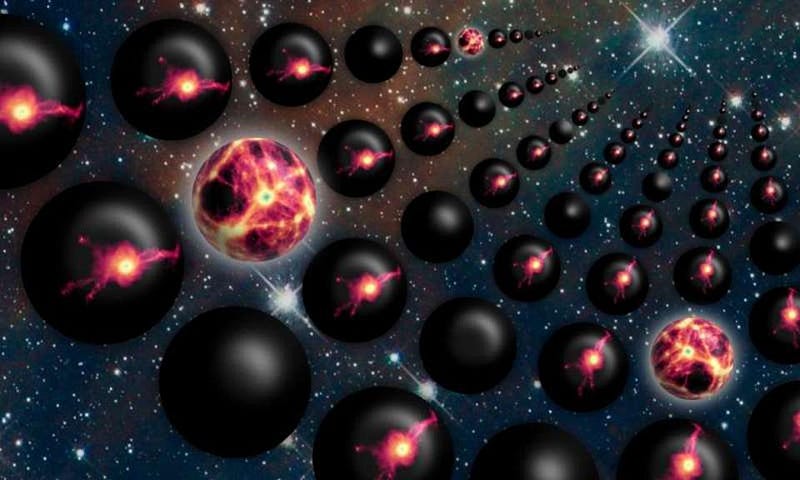
Most of us, when we think about the multiverse, have this picture of a large — possibly even infinite — number of Universes that came into existence some time ago, with our Universe as we know it being just one of them. Moreover, we can only observe a fraction of our Universe: the observable Universe, which extends from our perspective for ~46 billion light-years in all directions.
Although we don’t see anything special about the boundary of what we can see, since it’s set by the speed of light and the amount of time that’s elapsed since the Big Bang occurred in our expanding Universe, we cannot know for certain how far our Universe extends beyond the limits of what we can observe. It could continue to go on for a great, immeasurable distance; it could even extend infinitely in all directions; but it could also come to an end just beyond the limits of our cosmic horizon. No matter how long we wait, there’s always going to be a limit to the volume of space that’s visible to our eyes.
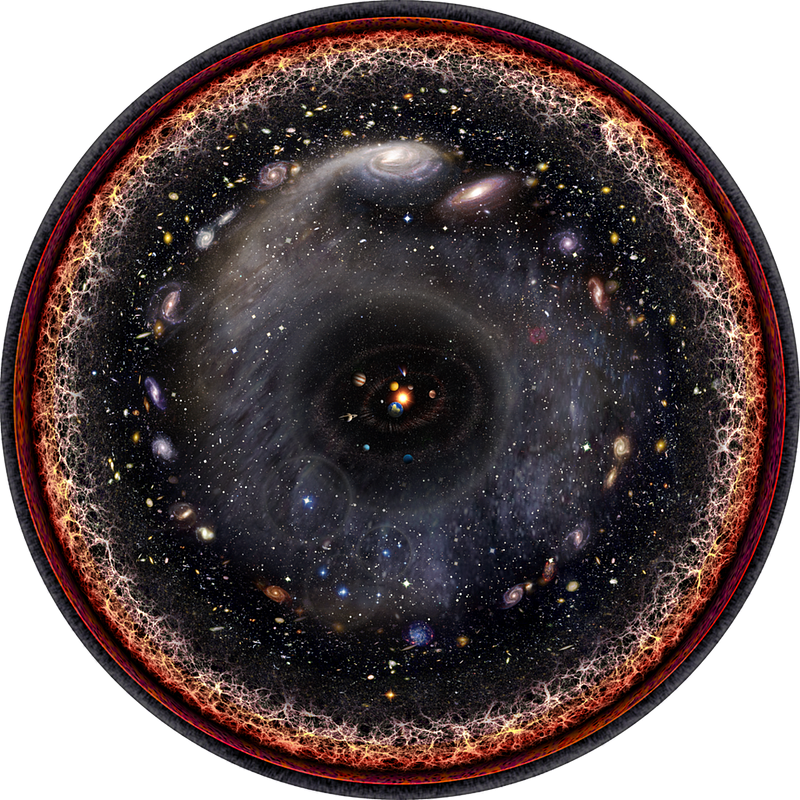
Fortunately, though, studying what we can see gives us an idea of what might lie beyond the limits of our possible perception. Even though the Universe is expanding, and the signals within it are fundamentally limited by the speed of light, there are a few interesting “signposts” for what’s out there at a particular distance. We exist now: 13.8 billion years after the hot Big Bang first occurred. We live in a Universe that’s expanding at a measurable rate of approximately 70 km/s/Mpc, which means that for every megaparsec (about 3.26 million light-years) of distance between us and another object, it will appear to be receding from us at about 70 km/s, on average.
Given that we know what makes up our Universe in terms of the various energy components — about 68% dark energy, 27% dark matter, 4.9% normal matter, 0.1% neutrinos, and about 0.01% photons (light) — we can say a lot about what certain cosmic limits are.
- A galaxy farther than ~18 billion light-years away will never be reachable by us, even if we left today at the speed of light.
- An object ~46 billion light-years away, today, will see the Big Bang’s light from our location first arriving now, while we will see light from that point as it was 13.8 billion years ago.
- And an object presently about ~61 billion light-years away, although invisible to us today, will be the farthest object from which light will ever arrive at our eyes.
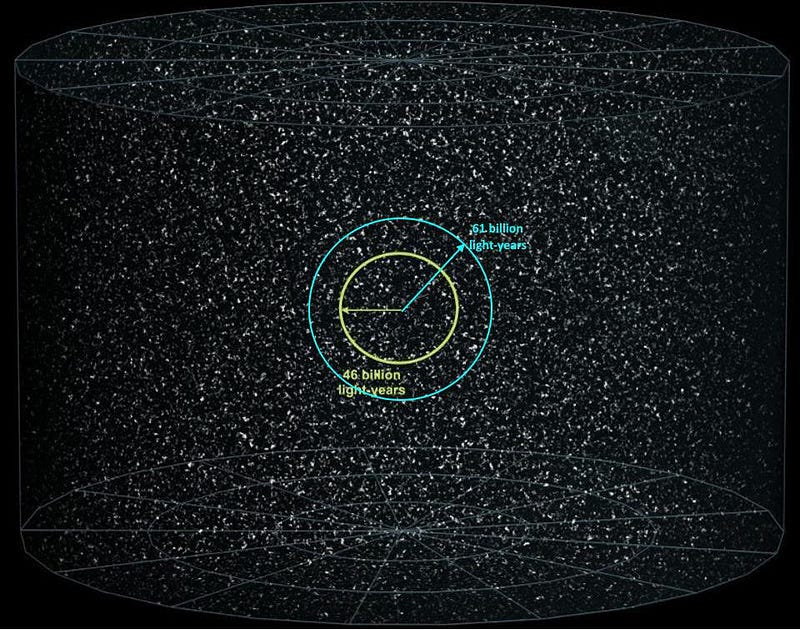
Those are the limits of our observable Universe only; we don’t know how much farther the unobservable Universe — which originated from the same Big Bang as our own — goes on for. We can place constraints on it, of course. If the Universe loops back on itself or otherwise repeats, the scale at which it does so is larger than the part presently observable to us. If it doesn’t, constraints on the amount of spatial curvature we have (it has to be less than ~0.002% of the Universe’s energy density) tell us that it must go on for at least ~400 times the part visible to us in all directions, or contain at least 64 million times the volume of our observable Universe. It could, quite possibly, even be infinite.
But no matter how big our Universe actually is, that doesn’t mean it’s the only one. Even if the Universe is infinite, there can be others; remember that some infinities are bigger than others.
The key to thinking about this is to understand where the (physically motivated) idea of the multiverse actually comes from. It arises if you take seriously the idea of cosmic inflation, which is the best theory and mechanism we have for what came before, set up, and gave rise to the Big Bang itself.
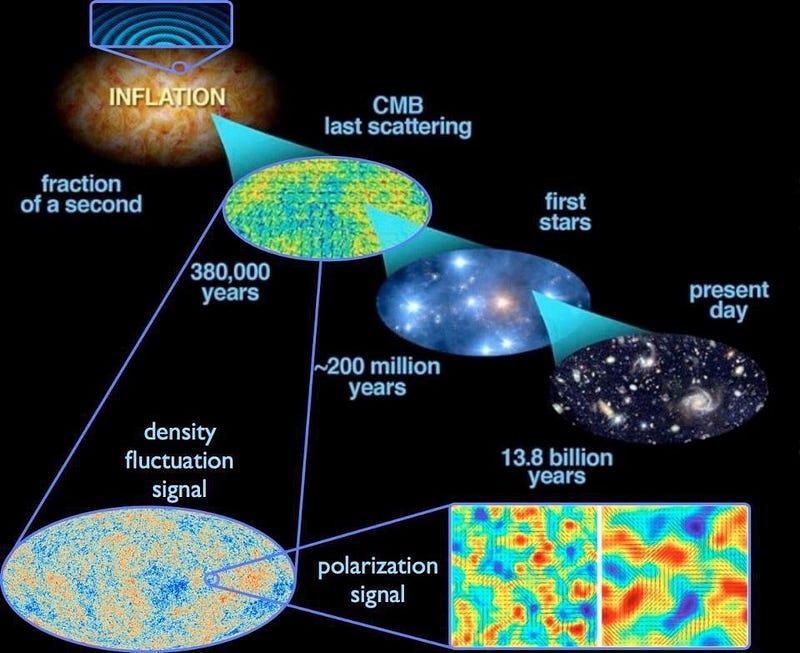
When we look out at the Universe and extrapolate what it must have been like at the start of the hot Big Bang, we find a few puzzling phenomena. We see that it’s the same temperature and density everywhere and in all directions, even though the distant regions to your left and right haven’t had time to exchange information or communicate over the known history of the Universe. We see that the total energy density and the initial expansion rate must have been equal, at the start of the hot Big Bang, to approximately 25 significant digits, something that the Big Bang doesn’t explain. And we see that there are no leftover high-energy signatures from the early Universe, something that would be expected if the Universe rose to infinitely high temperatures and densities early on.
How is this possible? That’s where the idea of cosmic inflation comes in: perhaps the Universe had a phase preceding the hot Big Bang. In this phase, rather than being filled with particles, antiparticles, radiation, and other quantized forms of energy, the Universe is filled with a form of energy much like dark energy: energy inherent to the fabric of space itself. While it’s in this state, the Universe expands at a relentless, exponential rate. Only when inflation comes to an end does this energy get transferred into particles, antiparticles, and radiation, creating a hot Big Bang.
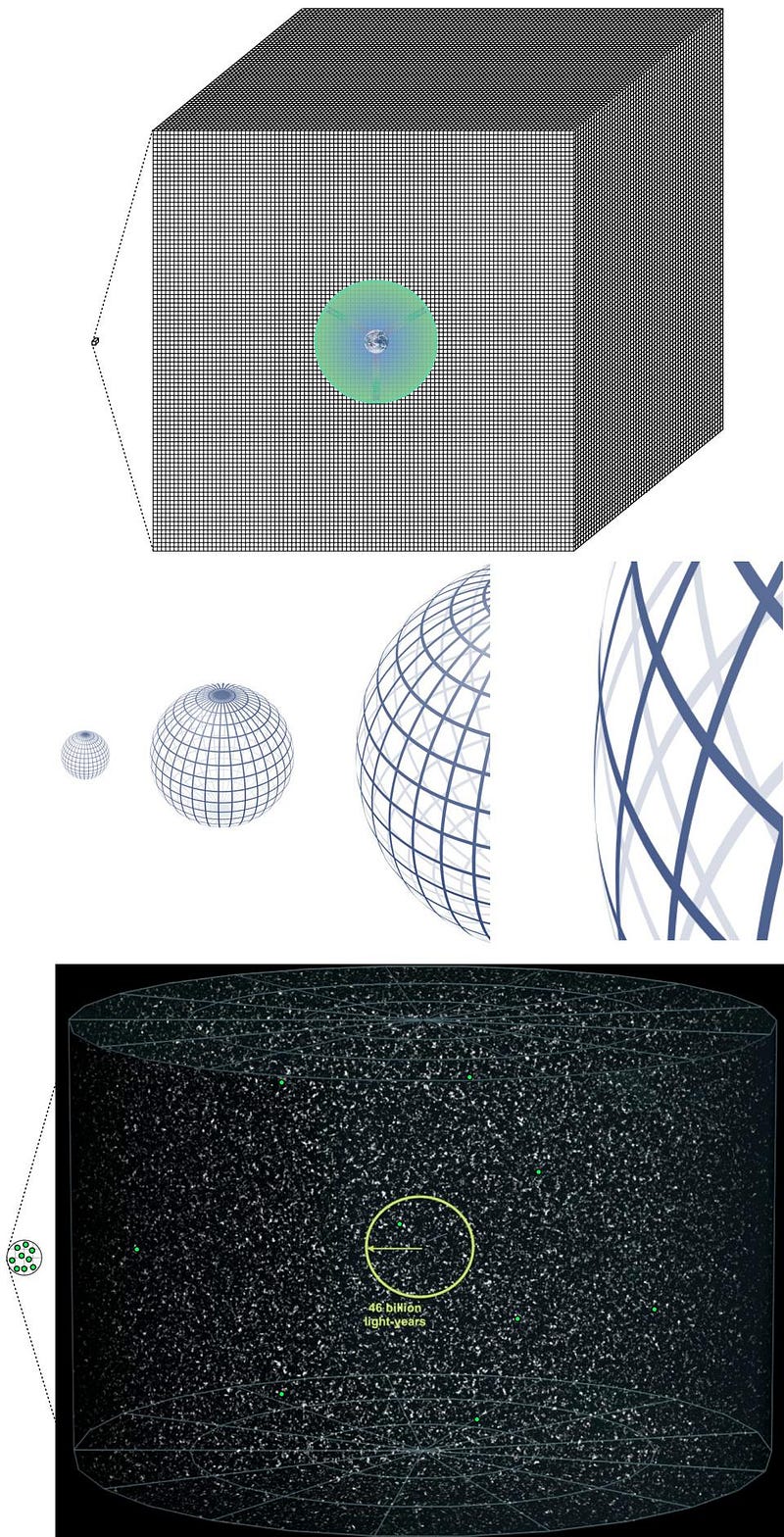
This is one of the biggest ideas in modern cosmology, and is also incredibly successful at both explaining what we observe and at making new predictions that we’ve been able to go out and test. The Universe has the same properties in all directions because it arose from space that was once all part of the same region, but was stretched to enormous scales by inflation. The energy density and spatial curvature balance because the dynamic of inflation determined both properties and forced them to balance. And there are no leftover high-energy relics because the Universe never reached arbitrarily high temperatures, but temperatures limited by the energy scale of inflation.
If inflation is also a quantum field — which it ought to be, considering that everything in the Universe is (probably) fundamentally quantum in nature — that means it experiences quantum fluctuations. Energy fluctuations create overdensities that grow into galaxies, and also underdensities that grow into cosmic voids. We can picture inflation as being a ball atop a very flat hill, but as ending when it rolls into a valley below. If there are quantum fluctuations, however, that means there are some “pockets” of the inflationary Universe where inflation ends earlier, others where it ends later, and still others where it must still be ongoing, even today.
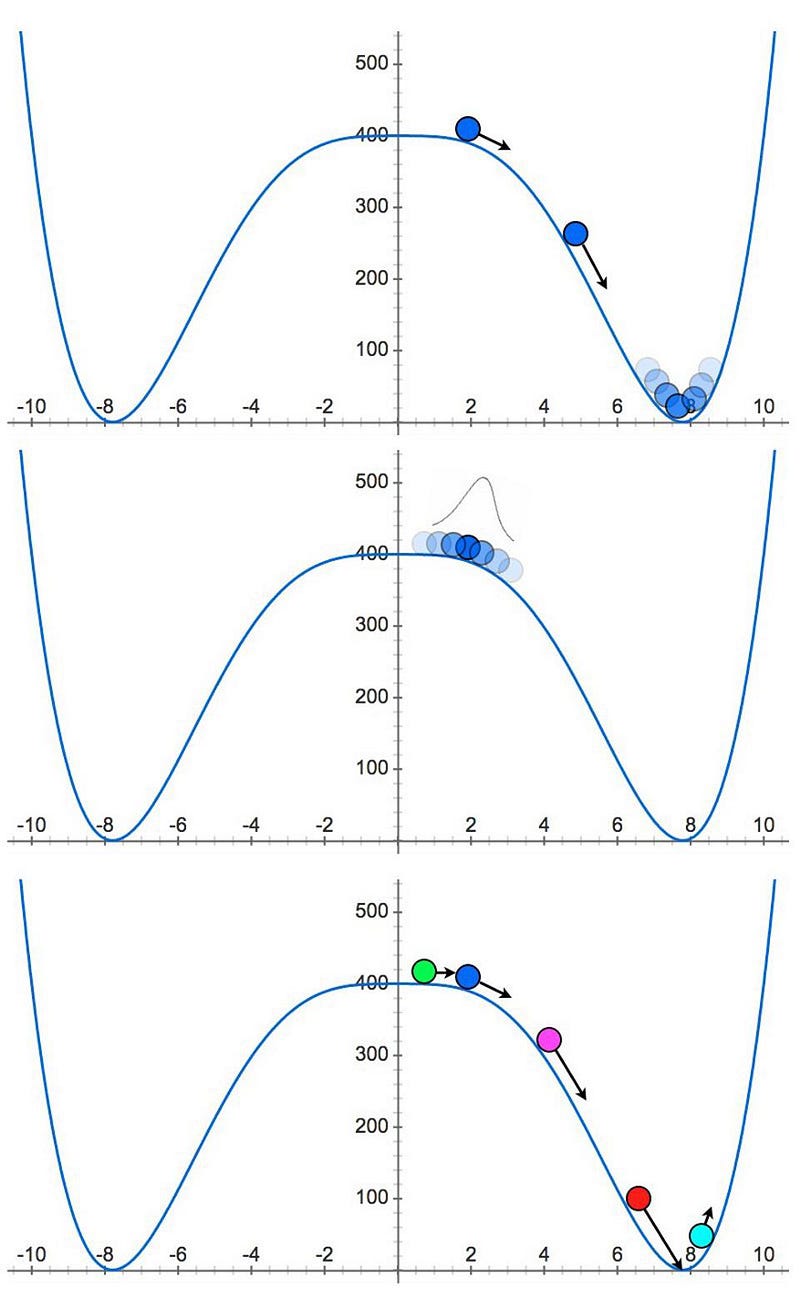
Wherever inflation comes to an end — no matter how big or small the region is where that happens, no matter where or when it occurs, and no matter whether the regions surrounding it are still inflating or not — you get a hot Big Bang and a new chance at a Universe like ours. There’s a lot we don’t know, even in theory, about these multiple Universes, but if inflation is correct and the laws of physics that we know are still valid during it, their existence is all but inevitable. This is where the idea of the multiverse, from a pure physics perspective (with no appeals to philosophy, interpretations of quantum mechanics, or assumptions about the pre-inflationary Universe), arises from.
That’s where the idea of a Universe from nothing comes from. If “nothing” is the nothingness of empty space, but empty space started off in an inflationary state, not only will it give rise to a Universe like ours, but an extraordinarily large (and possibly infinite) number of independent Universes will arise as well. Each one will be filled with its own particles, antiparticles, radiation, and whatever forms of energy are allowed.
And yet, given this remarkable story, you might rightly worry exactly what we’ve been asked this week, “where did the energy for all of this come from?”
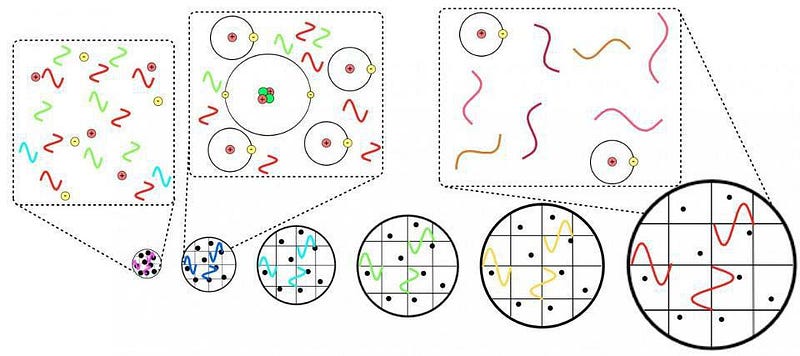
Here’s where things are really going to go against your intuition. You’ve no doubt heard about the law of conservation of energy: that energy can never be created nor destroyed, only transformed from one form into another. This is true for any event in the Universe, where an event is any interaction, conversion, or physical phenomenon that occurs at a point in space and a moment in time. Two colliding particles is an event; light striking a surface is an event; two observers meeting at the same place and time is an event. In every event that has ever occurred in the Universe, as far as we know, energy is conserved.
But for the entire Universe itself — or for a spacetime in general — energy isn’t always conserved, or even well-defined. Energy can only be well-defined if you’re in a static spacetime: one that’s the same, overall, from one moment to the next. The space around a black hole is an example of this: its properties don’t change so long as the black hole remains constant in mass. An expanding (or contracting) Universe, however, changes with time. As the space itself grows, the energy of different components changes in different, quantifiable ways.
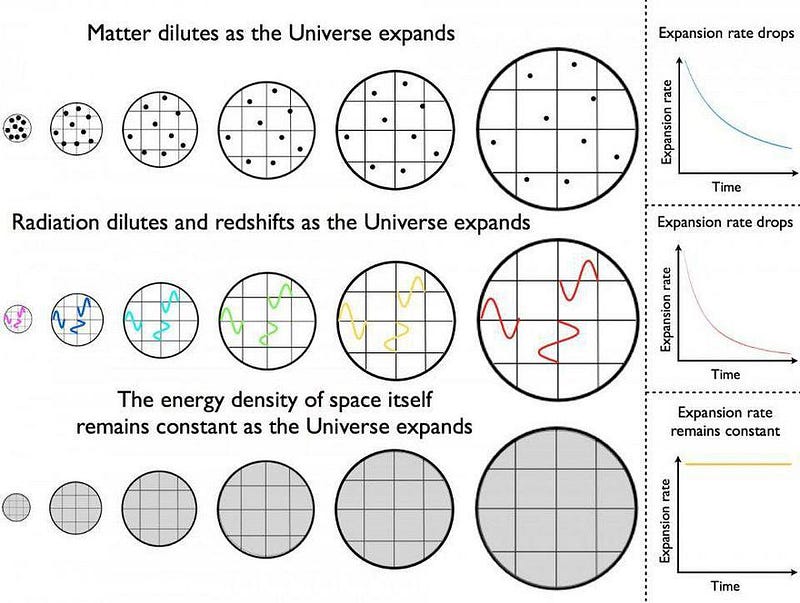
Both normal matter and dark matter, for example, are made of particles: they have a specific mass and occupy a specific volume. As the Universe expands, the number of particles stays the same, the volume increases, but the total energy remains the same.
Radiation, however, is different. Light waves have an energy that’s defined by their wavelength, where shorter wavelengths mean higher energies and longer wavelengths mean lower energies. As the Universe expands, the number of quanta of radiation stays the same, but the wavelength gets stretched to longer distances, causing each quantum to lose energy. As time goes on and the volume increases, the total energy drops.
Dark energy is also different. It’s an energy inherent to the fabric of space itself: a form of energy that has a small value today, but had a very large value during inflation. As space expands, the energy density remains constant, but the volume increases. The total energy of the Universe goes up over time, since energy equals density multiplied by volume.

This is unsatisfying to many, but it’s the truth: energy is neither conserved nor even well-defined for a Universe whose space expands or contracts over time. If you like, you can force energy to be conserved by imposing a global definition of energy: one where you can draw a boundary around a portion of the Universe and demand “energy must be conserved in here.” The only way to do it is to add in another definition: of work done on the boundary you drew as the Universe expands. Radiation does positive work, and that’s why it loses energy; dark energy (or inflationary energy) does negative work, and that’s why the total energy goes up.
As attractive as that imposition is, however, it isn’t a sound definition. It’s something we can simply choose to do — incorrectly, mind you — solely to fit our prejudice that energy must be conserved. The fact is that energy conservation only works at a particular location, not for the expanding Universe. You might have heard the expression that “there’s no such thing as a free lunch.” While that might be true here on Earth, that reasoning doesn’t apply to the expanding Universe. In fact, if ideas like inflation and the multiverse are correct, perhaps the real truth is that the Universe is the ultimate free lunch. In these trying times, this is one thing we can all be thankful for.
Send in your Ask Ethan questions to startswithabang at gmail dot com!
Starts With A Bang is written by Ethan Siegel, Ph.D., author of Beyond The Galaxy, and Treknology: The Science of Star Trek from Tricorders to Warp Drive.





